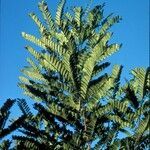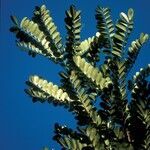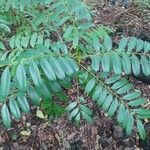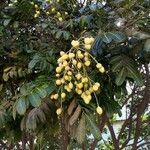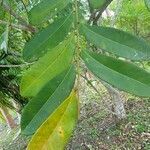Trees, 5-35 m high; branchlets reddish, glabrate. Leaves even-or odd-pinnate, to ca. 60 cm long; petiole and rachis reddish, minutely puberulent above in the sulcus, the petioles 4-7 cm long; leaflets 9-16, alternate to rarely subopposite, oblong to narrowly obovate or elliptic, rounded and abruptly short-acunfinate to occasionally retuse apically, inequilateral and cuneate basally, the margin entire and retuse, thick, coriaceous, dark green and lustrous above, paler and duller beneath, the midrib impressed above, prominent beneath, the lateral veins obscure, 2.5-11 cm long and 12-45 mm wide, the lowermost usually smaller, the petiolules 1-2 mm long, minutely puberulent above in the sulcus. Staminate panicles terminal, widely-branched, densely-flowered, reddish, minutely puberu-lent, to ca. 30 cm long. Staminate flowers campanulate, greenish or yellowish, subtended by deciduous spathulate bracts, the pedicels minutely puberulent, 2 mm long; calyx bowl-shaped, 5-lobed, deciduous, ca. 1 mm high, the lobes broadly triangular, ciliate; petals 5, ovate, upright and slightly spreading apically at anthesis, 4-5 mm long and to 3 mm wide; stamens 10, in 2 whorls, ca. 4 mm long, the outermost whorl slightly shorter, the filaments subulate, the appendages densely tomentose, the tomentum covering the disc and intertwining to cohere adjacent filaments; the disc ca. 1 mm high, 5-lobed; the gynoecium rudimentary. Carpellate panicles like the staminate, but fewer-flowered. Carpellate flowers like the staminate, but the pedicels to 5 mm long; petals 3-3.5 mm long; stamens reduced to 10 obovoid, beaked, pubescent staminodia 1 mm high; disc 10-lobed, less than 1 mm high, pubescent to glabrate; ovary obovoid, deeply 5-lobed, glabrous, 2 mm high, the style ca. 1 mm long, deciduous, the stigmas 5, recurved, ca. 1 mm long. Drupes 1-3 per flower, obovoid or ellipsoid, slightly compressed laterally, markedly contracted basally, with a medial ridge and a prominent sub-apical stylar scar, brownish-punctate, glabrous, green to reddish, becoming blue-black at maturity, ca. 1.5 cm long.
More
An evergreen tree. It grows 42 m tall. The crown is broad. There are flushes of new growth. The trunk is 50-60 cm across. The leaves are compound and 60 cm long. There are 9-16 leaflets and these are 3-11 cm long by 12-45 mm wide. The leaflets towards the top are smaller. Male and female flowers are on separate trees. The flowers are small and pale yellow. The fruit are 17 mm long and have large seeds. The seeds are 10-14 mm long.

